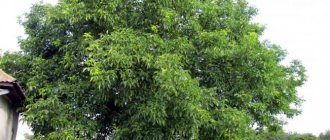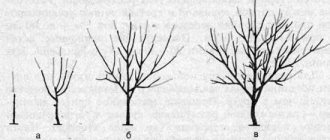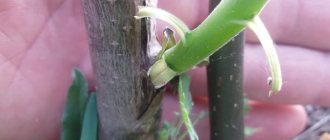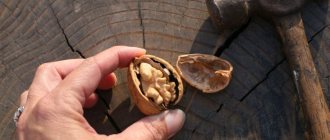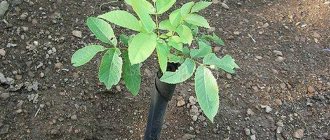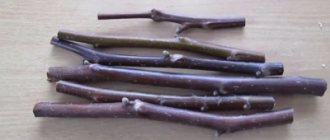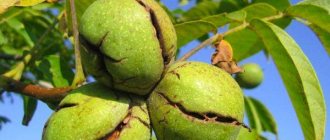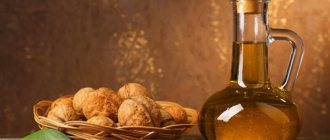The group to which a particular variety belongs influences when a walnut begins to bear fruit.
On average, the first nuts appear on the branches no earlier than 6-8 years. Some species produce crops only from 10-12 years of age. At the same time, there are also nuts that begin to bear fruit in the fourth year, and even earlier.
How long does a walnut grow before fruiting from the moment of planting?
Walnuts are among the longest-livers in the plant world, since under favorable conditions one tree can grow and actively bear fruit for hundreds of years. 50-year-old specimens are often called young, so it is not surprising that the first fruits on them can only form closer to ten years of age. On average, you can see nuts on plants already in the 6th–8th year of cultivation, however, there are varieties with early fruiting: already in the 4th year of cultivation.
Did you know? Walnuts are a good option for a natural sleep aid, due to the high magnesium content in the kernels. It is this that has a slight calming effect on the human nervous system, and in combination with honey, nuts perfectly relieve vasospasm and eliminate associated headaches.
Based on the specific time of the beginning of this process and the size of the fruits themselves, all varieties can be divided into 3 groups:
- Large-fruited (nuts grow up to 15 g), or ordinary (up to 12 g) - enter the fruiting phase in the 6th or 8th year of life. Examples of such varieties would be Skinossky, Pamyat Minova, Bomba.
- fruiting - characterized by early fruiting, starting from the 4th year of cultivation (the earliest of this group is considered the Ideal variety, which can please you with a harvest in the 3rd year of growth).
- Late-ripening (the first kernels are formed only by the 10th–15th year of life). In most cases, such late-ripening varieties include crops grown on the site from seeds. Grafted plants of the same varieties bear fruit much earlier.
To provide yourself with early nuts, it is worth considering the region of future tree growing. Late varieties are often more resistant to cold, but early varieties can freeze in harsh climatic conditions.
Harvest time
Since there are a large number of varieties of this amazing tree, we will highlight three. Why so few? It's simple, they are considered the most productive. So, the varieties and what year the walnut bears fruit after planting:
Bulganak will delight you with its first harvest in its fifth year. Its large round nuts contain fatty acids. The giant grows up to 10 meters.
At Burliuk's you can try nuts in the sixth year. It differs in that the thin walls of the fruit have high strength. This is why pests cannot get inside. But the protein in these nuts is as much as 30% more than that of the nut described above.
Arkad gives nuts for the seventh year. The fruit has a very strong shell. Its value increases due to the large amount of fat.
It is also important that the royal nut (one of the names) grows in an area with a temperate continental climate. This means that it can easily adapt to both summer heat and winter cold. But the abundance of light is important to him, as it promotes the development of the crown and the early appearance of the harvest.
How and with what frequency does it bear fruit?
Average-yielding walnut varieties produce approximately 8–10 kg of nuts per year, but as the plant matures, these figures can increase annually by 20–30 kg per tree. Fifty-year-old specimens often produce several centners of fruit, although this is the exception rather than the rule.
Learn all about walnut flowering.
The most productive varieties of the crop in question include:
- Ideal (up to 110 kg hearths at a 20-year-old tree).
- Bukovinsky 2 (about 50 kg of harvest is harvested from one 20- or 25-year-old tree).
- Chernovetsky (40–45 kg of nuts from a 20-year-old plant).
At the initial stages, each of these varieties can produce no more than 5–10 kg, and not all fruits will be large. To determine the most appropriate time to remove fruits from a tree, you should pay attention to the pericarp: if large cracks appear on them, the ripening of the walnut is coming to an end, and you can prepare for harvesting work. The exact timing depends on the characteristics of the variety being grown, but usually the process begins in late August and ends in October.
How do you care for a planted tree?
Caring for young trees includes watering, fertilizing the soil, pruning and controlling walnut pests.
Watering
When the tree is in the active stage of flowering and fruit ripening, it requires careful watering. The irrigation rate is 30 liters of water per 1m2 of land on hot days. When it rains frequently, a lot of moisture is retained under the tree, and twice a month is enough for it.
The very first watering of the seedling compacts the soil, and the depression formed after planting is filled with soil. An experienced gardener always makes a small mound of earth around the tree to prevent excess moisture or, conversely, its leakage when watering.
Feeding the soil
Walnuts are fertilized no more than twice a year in spring (nitrogen) and autumn (phosphorus and potassium). A tree that is more than 20 years old requires ammonium nitrate, superphosphate, and potassium salt. To avoid burns, you should avoid getting fertilizer on the roots.
Important! Young trees under four years old should not be fed with nitrogen fertilizers. If you do not follow this rule, the tree will not bear fruit well. In addition, these fertilizers are a beneficial environment for bacteriosis.
Experienced gardeners know that if you plant lupine, peas or oats under a walnut in the spring, they will perfectly fertilize the soil naturally and provide the owner with a good harvest.
Trimming
When the walnut grows to a significant size, the gardener is faced with the question of how to properly trim and shape the walnut crown. This is a fairly plastic tree, and its pruning does not include crown formation. Only dry branches and those that rub and interfere with each other, damaging the bark, are removed. You can safely trim and thin it.
Important! Walnut pruning is done not in autumn and spring, when sap flows, but in June. Large branches are not cut off entirely, leaving a small twig. The next year, they cut it down too, covering the wound with garden varnish.
Control of diseases and harmful insects
Pests do not like walnuts, but they can also attack them.
- white American butterfly - where the most caterpillars have accumulated, treatment is carried out with chemicals or folk remedies, infusions and decoctions of herbs;
- codling moth - for successful control, pheromone traps are used from May to September. They lure males and spray them with viral agents. You also need to remove damaged leaves and nuts;
- aphids are also destroyed by insecticides and folk remedies;
- the sapwood is afraid of chemicals and at the first signs of damage, diseased walnut shoots are pruned.
Diseases in trees occur from a lack of light, water or, conversely, an excess of them.
- brown spot (marsoniosis) is the main and common disease of nuts. Occurs in humid weather with frequent rain. To protect against spotting, it is advisable to buy tree varieties that can survive in a given climate. Treat young seedlings with Bordeaux mixture or similar preparations that can resist marsoniosis. It is better to carry out primary chemical treatment of wood before the buds open;
- bacteriosis – in warm and humid weather this disease can also develop. It is stopped by spraying with Bordeaux mixture and 1% urea solution. The tree is treated twice with a two-week break;
- root canker can destroy the entire tree. All fruit trees and shrubs are susceptible to this disease. It affects the roots, forming growths on them that should be removed. The wound is treated with a 1% caustic soda solution. After this, the roots on the surface need to be washed with water.
Of course, it is not recommended to treat a whole nut, 25 m high, with poisons, but small, still fragile seedlings can be protected and treated.
How to achieve early fruiting?
The growth and development of a young nut seedling takes time, which means you will be able to try tasty and healthy nuts no sooner than in 2-3 years. Not all gardeners like this state of affairs, so many of them try to artificially speed up the time of harvesting the first harvest. There are several ways to do this.
Important! Such transplants can be performed only in the spring, using healthy young plants of the second or third year of cultivation.
The simplest option would be to replant the plant two or three times, with intentional damage to the vertically growing roots (mechanical impact should be moderate, otherwise the plant will die). If you believe the reviews, then such actions stop the growth of the crop in height and activate the development of flower buds.
The second, no less well-known way to accelerate the fruiting of walnuts is ringing, which is performed in the middle of the summer season, having previously selected only four- or five-year-old plants. The process itself involves organizing a circular cut on a skeletal branch, only so as not to touch the wood (only the bark is removed).
A similar ring is made a little higher (approximately 2 cm from the first mark), covering the wound surface with garden varnish. Such measures will stimulate the redirection of the plant’s vital juices from the root system to the generative buds, which will contribute to their rapid development and further formation of fruits.
Video: how to force trees to bear fruit early
Features of the precocious form
The main advantage of early-fruiting varieties is that they begin to bear fruit earlier than others. An ordinary tree grown at home begins to produce its first fruits at the age of 6 years, but early-ripening plants already at 3 years. The first type of such walnut was found in the Tashkent region less than a century ago. It begins to actively bloom at three years of age, and exactly one year later it also actively bears fruit.
Such varieties first form brushes, on which flowers form over time. After the flowering period, the first fruits begin to form. The growing type first produces four nuts on one inflorescence, but after a year about a dozen of them appear. This trait is present only in early ripening varieties.
The first fruits form immediately after flowering
Can a single walnut bear fruit?
Many varieties of walnuts are self-fertile plants, which means that in order to obtain a harvest, you will have to plant other varietal varieties of this crop nearby. The optimal planting radius is up to 200 m, and the best pollinating varieties are Marion, Spectrum, Orion, whose fruit weight averages 11–17 g. Due to their high frost resistance, all of them are recommended for planting in the central zone of the Russian Federation.
Familiarize yourself with the characteristics of walnut ripening.
The most popular self-fertile varieties include Giant and Ideal, but for them the possibility of cross-pollination will not be superfluous: if there is a suitable neighbor, the yield indicators will only increase, of course, if they bloom together.
Conditions and care
In order for fruiting to occur as early as possible, a number of conditions must be met when planting a walnut and caring for it. Firstly, it is worth purchasing a frost-resistant variety, since walnuts freeze at temperatures below –30°C. Secondly, in the spring, the green foliage of young nuts should be protected from return frosts. Thirdly, this plant is light-loving and may die in shade, especially in the first years after planting.
Walnuts are moisture-loving and will not grow in dry soil. The best soils for it are soils with a high humus content, loamy, sandy loam or sod-podzolic soils.
Sources:
https://fermer.blog/bok/sad/orehi/greckiy-oreh/12499-cherez-skolko-let-plodonosit-greckij-oreh.html https://selomoe.ru/sadovodstvo/oreh/greckij-kogda-nachinaet -plodonosit.html https://www.kakprosto.ru/kak-891772-skolko-rastet-greckiy-oreh-do-plodonosheniya
Why doesn't the walnut bear fruit?
Sometimes it happens that under suitable growing conditions, nut fruiting is delayed, and after 10–12 years, gardeners are unable to obtain at least a minimal yield from the plants. Even if at first glance it seems to you that everything is fine with the plant, this is not necessarily the case, so it is worth considering all possible reasons for the lack of fruiting.
Incorrect pruning
The lack of flowering, and therefore fruit set, can be explained by improper pruning of the crown. It is quite possible that most of the lateral non-fruit shoots have grown so much that they have begun to thicken the fruit shoots, and even here it is possible that they were pruned incorrectly.
Factors influencing life expectancy
There are many factors that can either increase or shorten the lifespan of this plant. This is influenced by:
- Soil composition, amount of watering and fertilizers.
- Pests, diseases and fungi.
- Location (it is clear that a tree standing next to the road will live less).
- The environment, the presence of other plants nearby.
It is better not to plant apple, pear and peaches next to it.
If you have already decided to plant your tree, then do not forget that it requires careful care, and also that you will not get a harvest right away. It’s better to wait a few years and get high-quality, ripe and tasty nuts than to rush ripening and end up with nothing.
Preventive actions
Standard preventive measures when growing nuts will include monitoring the condition of the plants, moderate watering and fertilizing, as well as periodic treatment with fungicidal or insecticidal preparations, which is especially important in cases where there have already been cases of disease outbreaks or pest infestations in a particular area.
Examples of such processing may include the following:
- Against marsonia, three times spraying with a solution of copper sulfate and quicklime, taken in a 1:1 ratio and diluted with a small amount of water, will be relevant. Moreover, in spring, nut buds can be sprayed with Vectra, the working solution of which is prepared in accordance with the instructions on the package. In this case, the break between treatments should be at least 2–3 weeks.
- The trees will be protected from bacteriosis by the same mixture of lime and copper sulfate, and the spraying scheme is almost completely consistent with the previous one.
Video: spraying a tree
In addition, to better protect plantings, gardeners recommend regularly removing fallen leaves and burning parts of the plant affected by diseases or pests, which will eliminate the likelihood of the infection in it spreading.
In general, with a responsible approach to the issue of choosing a walnut variety and organizing further full care for it, no problems should arise: fruiting will always begin on time, lasting as long as possible.
How can you tell when a tree is starting to bear fruit?
The main sign that the harvest will soon appear is the flowering of the nut. It occurs in April-May, when characteristic “catkins” consisting of male and female flowers appear on the branches.
Following flowering, if the flowers have been properly pollinated, the ovary begins to appear. Depending on the variety, either individual nuts or rosettes of several nuts growing on one shoot can be formed.
Next in the video you can see how the tree blooms and what the resulting fruits look like:
Pests and diseases: control measures
Compared to other trees, walnut is less often affected by pests and diseases. But nevertheless, some “friends of the garden” visit it:
- American white butterfly . It produces three generations over the summer, and the third is the most harmful. The butterfly caterpillars, having settled on the leaves, gradually move throughout the tree. To combat them, microbiological preparations or insecticides can be used.
- The apple or walnut moth brings 2 generations. The caterpillars crawl inside the nut, eating away its contents. Infected nuts fall off. The method of control is pheromone traps that attract males. Reproduction is reduced, and there are fewer caterpillars. They are treated with viral drugs that cause caterpillar disease and death. A mechanical method is also used: collecting caterpillars and affected fruits by hand.
- Aphids settle on young shoots and buds, forming colonies on the inner leaf surface. Chemicals are used for destruction.
- Sapwood is a beetle that lives under the bark, so it is difficult to detect. Gnawing out the bark of a tree, it leaves behind curved channels. Beetles settle on weak plants and cause abundant sap flow. Over the summer, 2 generations are formed. Control measures: spraying with insecticides. Prevention - sanitary cutting of damaged branches.
A tree can also get sick for physiological reasons: poor soil, lack of light, excess moisture, spring frosts, poor care.
Most often, walnuts are affected by brown leaf spot , fire blight , bacteriosis , and root canker .
Popular frost-resistant varieties
There are 4 forms of walnut: English or Persian , White , Black , Japanese . All of them are representatives of this family. Nut.
As for varieties, the walnut crop is southern, brought from Central Asia. And for a long time it was believed that its habitat was the warm regions of our country. Today on the market there are already winter-hardy, productive varieties that are practically not affected by pests and diseases, which can be grown in central Russia and the Moscow region.
- Dessert . It is distinguished by early ripening and nuts with a sweetish taste. Tree height is average. The crown is wide. The culture is drought-resistant. Winter hardiness is average: in cold weather the buds may freeze. Fruiting begins in the 4th season.
- Graceful . A low-growing tree (4–5 m) with an oval crown. Characterized by average resistance to frost. Nuts ripen in the 5th year. They are collected in early autumn.
- Aurora . Early, tall walnut. The fruits appear in the 4th year, and with the new season the yield increases. Resistant to frost, not susceptible to disease.
- Ideal . Early fruiting variety. Well known to Russian gardeners. It is loved for its high yield and winter hardiness (can withstand temperatures down to -35⁰C). The flowers form inflorescences and real grape clusters of nuts grow (up to 15 pieces).
Landing
The best method of propagation is to obtain a crop from seeds. In this case, you can be sure what fruits you will get in the end. Select a tree and collect several fruits from it. The seedling grown from such fruits will be well acclimatized to local conditions.
Attention! To grow a crop, it is worth planting more than one tree. The distance between seedlings is 5 m. Keep in mind that over time the crown will grow. On slopes, denser planting is permissible - every 3.5 m.
Walnuts should be planted in sunny, illuminated places. In relation to soils, the plant is unpretentious. It is “satisfied” with different types of soil and varied terrain. But it should not be planted in wet, sandy or poorly aerated areas. Close proximity to groundwater is undesirable.
The landing technology is as follows:
- We plant in the spring, because autumn planting can lead to the death of poorly strengthened seedlings from frost.
- Planting time is April (more specifically, the time is determined based on the region).
- The planting hole (50x50 cm) is prepared in advance; a rich earthen mixture is poured into it. Mixture composition: compost + ash + superphosphate. You can add humus.
- We straighten the roots, gradually sprinkling them with earthen mixture. We water it. We compact the soil around the seedling.
- The root collar is covered with soil by 5 cm.
The first fruits should appear in 4 years.
Walnut - planting and care
The plant does not require care. While it is small, you can grow vegetables between the trees.
Conditions for culture
It is necessary to water twice a month as soon as the plant begins to grow. During periods of drought, when the soil dries out, watering is also important. For wood – 30 l. water per m².
We fertilize the crop 2 times a year: nitrogen - in the spring, potassium and phosphorus - in the autumn.
Walnut loves warm climates with a gradual transition to winter dormancy. Modern varieties can withstand more continental climates and lower temperatures. But spring frosts can damage young shoots and fruit buds.
It is better to plant walnuts on a flat surface. Slopes are suitable, but the slope is no more than 10⁰. Prefers southern and southwestern slopes.
Wind is necessary for pollination, but plantings must be protected from strong winds.
Pruning and crown formation
It is important to lay the first branches of the skeletal layer. When pruning, leave 4 branches in different directions at an angle of 45⁰. Young, standard shoots are removed. Subsequently, the tree forms independently. Only sanitary pruning will be necessary.
Attention! Nitrogen fertilizers must be applied with great care, as they can cause the development of bacterial diseases. At the beginning of seedling growth, you should not add them at all.
